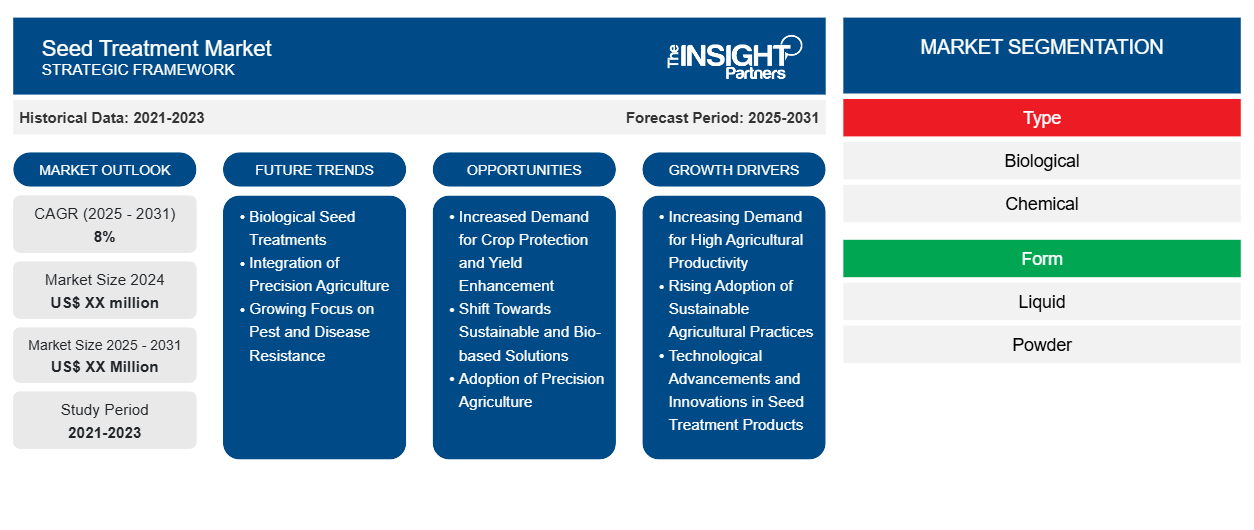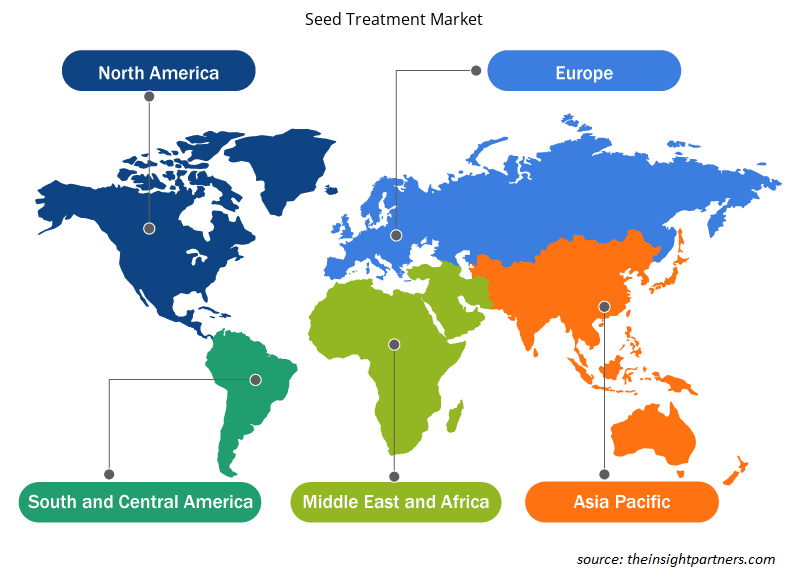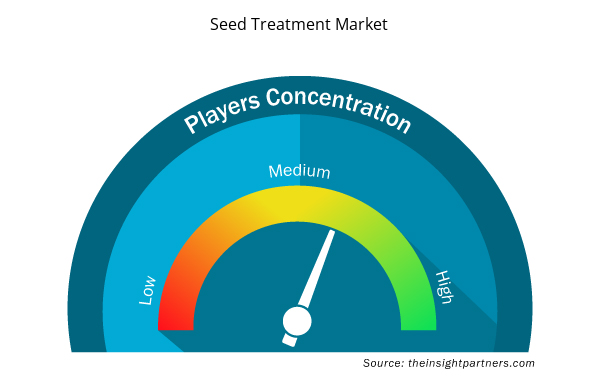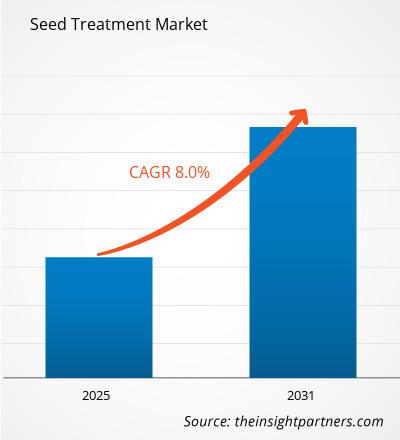The Seed Treatment Market is expected to register a CAGR of 8% from 2025 to 2031, with a market size expanding from US$ XX million in 2024 to US$ XX Million by 2031.
The seed treatment market report is segmented by type (biological and chemical). The market is segmented based on form (liquid and powder). The market is segmented based on method (seed dressing, seed coating, and seed pelleting). The market is segmented based on crop type (cereals and grains, oilseeds and pulses, fruits and vegetables, and others). The market size and forecast at global, regional, and country levels for all the key market segments are covered under the scope. The report offers the value in USD for the above analysis, segments, regions, and countries. The report covers market trends, as well as market dynamics such as drivers, restraints, and key opportunities. The report also covers industry landscape and competition analysis covering market concentration, heat map analysis, prominent players, and recent developments in the market.
Purpose of the Report
The report Seed Treatment Market by The Insight Partners aims to describe the present landscape and future growth, top driving factors, challenges, and opportunities. This will provide insights to various business stakeholders, such as:
- Technology Providers/Manufacturers: To understand the evolving market dynamics and know the potential growth opportunities, enabling them to make informed strategic decisions.
- Investors: To conduct a comprehensive trend analysis regarding the market growth rate, market financial projections, and opportunities that exist across the value chain.
- Regulatory bodies: To regulate policies and police activities in the market with the aim of minimizing abuse, preserving investor trust and confidence, and upholding the integrity and stability of the market.
Seed Treatment Market Segmentation
Type
- Biological
- Chemical
Form
- Liquid
- Powder
Customize This Report To Suit Your Requirement
You will get customization on any report - free of charge - including parts of this report, or country-level analysis, Excel Data pack, as well as avail great offers and discounts for start-ups & universities
Seed Treatment Market: Strategic Insights

- Get Top Key Market Trends of this report.This FREE sample will include data analysis, ranging from market trends to estimates and forecasts.
Seed Treatment Market Growth Drivers
- Increasing Demand for High Agricultural Productivity: As the global population grows, there is a rising demand for enhanced crop yields. Seed treatments, which protect seeds from pests, diseases, and environmental stresses while promoting better germination, are essential in improving productivity. Farmers increasingly rely on seed treatments to ensure optimal crop performance and maximize yields, driving market growth.
- Rising Adoption of Sustainable Agricultural Practices: With increasing awareness of environmental sustainability, there is a shift towards eco-friendly and organic farming. Seed treatments, especially those based on biological or natural products (such as bio-stimulants and bio-pesticides), are becoming popular as they offer a safer, sustainable alternative to chemical-based solutions. This trend is fueling the demand for innovative, green seed treatment solutions.
- Technological Advancements and Innovations in Seed Treatment Products: Continuous advancements in seed treatment technologies, such as enhanced coatings, microencapsulation, and improved formulation of active ingredients, are driving the market. These innovations help improve seed protection, disease resistance, and nutrient delivery, contributing to the growing adoption of seed treatments across various crop types, from cereals to vegetables.
Seed Treatment Market Future Trends
- Biological Seed Treatments: There is a growing shift towards biological seed treatments, such as microbial and natural-based products. These treatments improve seed health by promoting beneficial soil microbes and enhancing disease resistance. They align with the increasing demand for organic and sustainable farming practices, reducing the reliance on chemical pesticides.
- Integration of Precision Agriculture: The use of precision agriculture technologies, such as digital monitoring and data analytics, is transforming seed treatment practices. This trend allows farmers to apply treatments more efficiently and precisely, optimizing crop protection and reducing waste. Tailored seed treatments based on soil and environmental conditions are gaining popularity.
- Growing Focus on Pest and Disease Resistance: With climate change influencing pest dynamics and the spread of diseases, there is an increasing focus on seed treatments that provide robust protection against these threats. Fungicides, insecticides, and nematicides are being increasingly incorporated into seed treatments to safeguard crops and ensure higher yields.
Seed Treatment Market Opportunities
- Increased Demand for Crop Protection and Yield Enhancement: Seed treatments, including fungicides, insecticides, and growth stimulants, are crucial for protecting seeds from diseases and pests while promoting better germination and early plant growth. As farmers seek ways to improve crop yield and protect against environmental stresses, the demand for effective seed treatments is growing globally.
- Shift Towards Sustainable and Bio-based Solutions: With rising concerns about the environmental impact of chemical pesticides, there is an increasing shift toward sustainable and bio-based seed treatment products. Biological seed treatments, such as beneficial microbes and plant extracts, are gaining popularity as alternatives to traditional chemical treatments, supporting eco-friendly farming practices and driving market growth.
- Adoption of Precision Agriculture: The growing adoption of precision agriculture technologies, which use data-driven methods for optimizing crop management, is expanding the demand for seed treatments. Customized seed treatments that cater to specific soil conditions, crops, and pest profiles are becoming increasingly popular, enhancing overall crop productivity and supporting market growth.
Seed Treatment Market Regional Insights
The regional trends and factors influencing the Seed Treatment Market throughout the forecast period have been thoroughly explained by the analysts at Insight Partners. This section also discusses Seed Treatment Market segments and geography across North America, Europe, Asia Pacific, Middle East and Africa, and South and Central America.

- Get the Regional Specific Data for Seed Treatment Market
Seed Treatment Market Report Scope
| Report Attribute | Details |
|---|---|
| Market size in 2024 | US$ XX million |
| Market Size by 2031 | US$ XX Million |
| Global CAGR (2025 - 2031) | 8% |
| Historical Data | 2021-2023 |
| Forecast period | 2025-2031 |
| Segments Covered |
By Type
|
| Regions and Countries Covered | North America
|
| Market leaders and key company profiles |
Seed Treatment Market Players Density: Understanding Its Impact on Business Dynamics
The Seed Treatment Market market is growing rapidly, driven by increasing end-user demand due to factors such as evolving consumer preferences, technological advancements, and greater awareness of the product's benefits. As demand rises, businesses are expanding their offerings, innovating to meet consumer needs, and capitalizing on emerging trends, which further fuels market growth.
Market players density refers to the distribution of firms or companies operating within a particular market or industry. It indicates how many competitors (market players) are present in a given market space relative to its size or total market value.
Major Companies operating in the Seed Treatment Market are:
- Syngenta
- BASF SE
- Corteva Agriscience
- SUMITOMO Chemical Co Ltd
- Mitsui and Co Ltd
Disclaimer: The companies listed above are not ranked in any particular order.

- Get the Seed Treatment Market top key players overview
Key Selling Points
- Comprehensive Coverage: The report comprehensively covers the analysis of products, services, types, and end users of the Seed Treatment Market, providing a holistic landscape.
- Expert Analysis: The report is compiled based on the in-depth understanding of industry experts and analysts.
- Up-to-date Information: The report assures business relevance due to its coverage of recent information and data trends.
- Customization Options: This report can be customized to cater to specific client requirements and suit the business strategies aptly.
The research report on the Seed Treatment Market can, therefore, help spearhead the trail of decoding and understanding the industry scenario and growth prospects. Although there can be a few valid concerns, the overall benefits of this report tend to outweigh the disadvantages.
- Historical Analysis (2 Years), Base Year, Forecast (7 Years) with CAGR
- PEST and SWOT Analysis
- Market Size Value / Volume - Global, Regional, Country
- Industry and Competitive Landscape
- Excel Dataset



Report Coverage
Revenue forecast, Company Analysis, Industry landscape, Growth factors, and Trends

Segment Covered
This text is related
to segments covered.

Regional Scope
North America, Europe, Asia Pacific, Middle East & Africa, South & Central America

Country Scope
This text is related
to country scope.
Frequently Asked Questions
Based on geography, Asia Pacific held the largest share of the seed treatment market due to the strong growth of the agriculture industry in the region.
Biological and organic seed treatments is expected to be the key market trends.
Based on crop type, the fruits and vegetables segment is expected to witness the fastest growth during the forecast period.
The Seed Treatment Market is estimated to witness a CAGR of 8% from 2023 to 2031
Increase in crop protection and yield enhancement needs is driving the market growth.
Syngenta, BASF SE, Corteva Agriscience, SUMITOMO Chemical Co Ltd, Mitsui and Co Ltd, Koppert, Nichino, Certis Belchim, Nutrien Ag Solutions, and Agriscope are the key players operating in the seed treatment market.
Trends and growth analysis reports related to Chemicals and Materials : READ MORE..
1. Arysta Lifescience India Limited2. BASF Corporation3. Bayer AG.4. DOW Agrosciences LLC.5. Dupont De Nemours Inc.6. FMC Corporation7. Monsanto8. Nufarm9. Sumitomo Chemical Co. Ltd.10. Syngenta AG.

 Get Free Sample For
Get Free Sample For